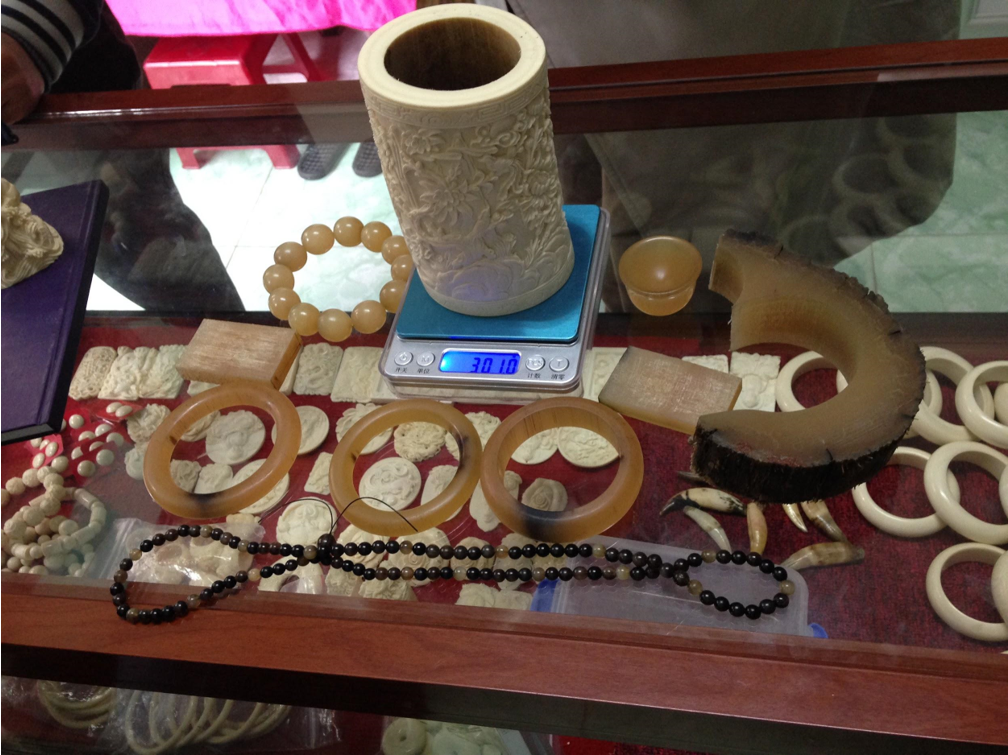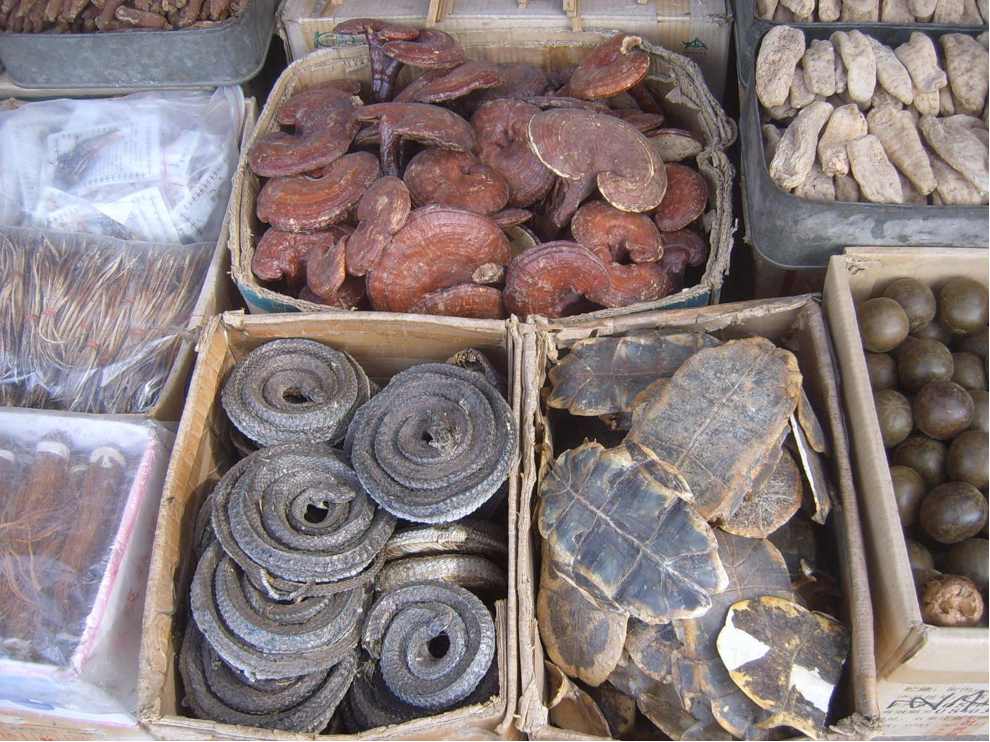- Thanks to technological advancements, it’s now possible to make synthetic versions of animal parts like rhino horn, elephant ivory, and big cat fur, demand for which is contributing to the extinction crisis.
- Yet this practice is controversial, as some conservation groups assert that selling synthetic parts could actually promote more poaching.
- Proponents of the strategy say more conversations are needed around this possibility, including looking at the issue from an economic perspective.
Twice a year, thousands of members of South Africa’s Nazareth Baptist Church clothe themselves in spots and walk to their holy grounds in KwaZulu-Natal province to take up a dance. Following the swell of horns and the pounding of a drum, more than 1,500 male dancers move together, their stamping feet and upraised arms swinging in perfect sync. On each dancer’s shoulders hangs an amambatha: a fur cape covered in dazzling leopard spots. They tie these dancers to Zulu royalty and chiefs, who have worn the capes for generations.
Despite their ancient origins, many amambatha now have a modern update: increasingly, dancers’ furs are made from plastic, pleather, and vinyl. They were developed in collaboration with Furs for Life, a project of the global wild cat conservation organization Panthera.
“The wearing of amambatha signifies the power and pride brought by the beauty of the cat,” Lizwi Ncwane, a Shembe elder, told Mongabay. However, in recent years, the church was made aware of significant local declines in leopard species. “All members are alive to the fact that there is a need to contribute to the conservation of the cat,” Ncwane said. “In so doing the teachings of the founder of the Church that we shall care about all species is upheld.”

According to Jeffrey Dunnink, the Furs for Life project coordinator, about half of the dancers at Shembe gatherings now wear a synthetic amambatha. The synthetic garments are not just significantly cheaper, but also remarkably faithful to the original leopard pelt: “When you look at the furs, you really need to get quite close before you see the difference,” he said.
It’s a good time to be in the business of fakes. Biotechnology, advanced materials science, and 3D printing have made it possible to not only make artificial cat skins, but also faux rhino horn, imitation elephant ivory, and a host of other wild animal replicas. Yet the work done by Panthera and their local partners is a rare example of this idea actually being put into practice for a conservation aim. Using synthetic animal products as a tool to curb the illegal wildlife market remains controversial in the conservation field.
“It’s almost a knee jerk reaction, if you talk to most conservationists — they don’t like synthetics, end of story,” said Frederick Chen, an economist at Wake Forest University who focuses on the economics of conservation, and who has modeled introducing synthetic products to the market. “While there is still a lot of detail and unknowns that need to be discussed and hammered out. The conversation in the community thus far has not been able to get to that point so far.”
The sticking point for many conservation groups is concern that artificial animal products could actually lead to a rise in poaching, by stoking demand for what consumers believe is the real deal.
Proponents of synthetics say there are conditions under which they could work, with the right products and the right infrastructure. Yet the overall resistance against the concept has prevented any progress in identifying the right conditions to try them.
“I think the conservationist field, sometimes, seems to feel that we propose it as an alternative. We propose it as an addition,” says Fritz Vollrath, a biologist at the University of Oxford who developed a method of creating highly faithful synthetic rhino horns. “Ramp up the protection, the surveillance, everything, of course. But in addition, try this. Because if it’s cheap, what are we losing?”
The case against synthetics
To understand the controversy over synthetics, consider the rhino horn. Rhino horn is most commonly used among practitioners of traditional Chinese medicine (TCM), where it is prescribed for a variety of ailments, from cancer to hangovers. Others use it as an aphrodisiac. In the Middle East, it is also carved into elaborate dagger handles.
It’s been illegal to sell rhino horn internationally since 1977, but that hasn’t stopped the trade. Rhino poaching peaked in 2015, and while it has declined year-over-year ever since, the group Save the Rhinos estimates that poachers kill a rhino in South Africa (home to about 80% of the world’s wild rhinos) roughly every 15 hours.

Several companies and individuals have sought solutions through synthetic replacements: from 3D-printed horns made of keratin, to Vollrath’s recipe of molded horse hair and a collagen-like glue. Across the board, these products largely aim to be indistinguishable from real rhino horn, in order to offer distinguishing customers a one-to-one replacement. By flooding the market with this cheap alternative, the theory goes, rhino horn prices will drop and poaching will no longer be profitable.
However, the very thing that makes these fakes appealing — their similarity to the real thing — elicits alarm. Some groups are concerned this could allow traders to launder real rhino horns by claiming they are fake, or attract new consumers who would otherwise avoid rhino horn because of its illegality. Others have raised the very real concern that these products would create unnecessary difficulty for law enforcement officers trying to root out illegal products.
In 2015, when media outlets widely reported on four companies that were working on synthetic rhino horn alternatives, a coalition of 10 rhino conservation groups warned that these products introduced a “very real risk of only exacerbating the rhino crisis by removing the stigma of rhino horn consumption and creating unnecessary obstacles for law enforcement.”
To prevent laundering, a synthetic product must be “100 percent distinguishable [from the wild product], easy for enforcement officers to see, and impossible for corrupt traders to get around,” Elizabeth Bennett, vice president of species conservation at the Wildlife Conservation Society, told Duke University researchers in a survey of conservation groups.

Evidence from other wildlife products also appears to weigh against the synthetics argument. A 2019 analysis by the U.S. National Bureau of Economic Research found that the announcement alone of a legal elephant ivory sale in 2008 led to a 61% increase in illegal ivory production across Africa and Asia, and an estimated 71% rise in smuggling ivory out of Africa. They conclude that the legal ivory sale increased demand for the product, and that releasing the legal stuff into the market helped mask illegal ivory — just as legally selling synthetic rhino horn might be used as cover for the illegal trade.
Even if synthetic alternatives were available, consumers may choose not to buy them. Chemical and herbal substitutes for bear bile, another popular ingredient in TCM, have been available for decades. These provide an alternative to both bear poaching and bear farming, a practice widely considered inhumane, and which itself removes bears from the wild. Yet these alternatives are still unpopular. What’s more, research shows that consumers even favor wild-harvested bile over farmed where possible.
“Some consumers believe that wild-caught animals have more power than captive-bred, and obviously more than synthetic, so there is a mindset that has to change among some buyers,” said Chris Shepherd, executive director of Monitor Conservation Research Society.
Economics and ethics
Yet Chen, the economist, argues that these scenarios don’t account for all the ways that synthetic animal products could be introduced to the market. These examples largely rely on what he calls the “overt approach,” when consumers can knowingly choose between synthetic and genuine products. Under this approach, he says, the market for an animal product will always survive on some level.
But if the aim is to destroy an illegal market, Chen says, then organizations and governments should instead take a “covert approach.” Here, synthetics would enter the market secretly. While they would appear outwardly indistinguishable from real products, the key to this approach would be to introduce some flaw in the product; perhaps they would degrade over time, or cause an adverse effect, like a stomachache if ingested.

This approach draws from the economics behind the used car market, known among economists as Ackerlof’s lemons market, after the researcher who first investigated it. “When you want to go out and buy a used car, you largely can’t tell if it’s a good car or a crappy lemon,” Chen explained. “And when you don’t know the difference, or you can’t tell, you’re unwilling to pay a high price.”
In a 2017 analysis, Chen showed that this principle could work for rhino horns. Word of the unreliable products would spread. Degrading consumer confidence would drive down horn prices, lowering the incentive to poach. And because this approach’s strength lies in economics and human psychology rather than biology, it’s not limited to one species — what works for rhino horn could likely also work for everything from pangolin scales to elephant ivory, tiger bones to dried seahorses.
“Take out the animal products and sub in apples, or Nike shoes, what do those problems sound like? These are questions of economics,” Chen said. “I think a lot of people think of conservation as just the realm of biologists, or ecologists, but at the end of the day fundamentally conservation is like an economics problem.”
There are ethical concerns when it comes to selling an inferior product. Lucy Vigne, an expert on the elephant ivory and rhino horn trade, pushed back against the idea in an interview with Mongabay.
“I think one can fairly suggest that consumers can be persuaded to switch, but trying to fool customers, that’s cheating,” she said. “I think one has to be very careful not to go down that line when we’re trying to do things in an honest way.” Vigne added that many TCM users in Vietnam and elsewhere follow the examples of their peers over pharmacists and doctors who might prescribe non-animal alternatives, highlighting the importance of locally-led public education campaigns.
Chen agreed that this presents a major ethical issue. Yet for him, this simply reinforces the main issue with synthetics in conservation: that stakeholders simply are not talking about how they could be applied.
“It goes back to the original point — if we’re serious about using these things, we need to sit down and think about: how do we do it? What are the ethical considerations? Where can we go or not go?” Chen said.
Changing culture
There is also a third option when it comes to introducing synthetic products. The Shembe people of South Africa are already living this option: a transition supported by the users, and based around cultural respect.
“I think it’s really critical that the communities themselves are key players, and key partners, within this entire process,” Panthera’s Dunnink said of the transition to synthetic products. The project originated with Panthera leopard monitor Tristan Dickerson, who had watched leopard populations decline inexplicably in South Africa. When Dickerson met a member of the Shembe Church, he recognized an opportunity to remove a significant local demand for leopard pelts.

Dunnink credits the success of the program to Dickerson’s respect for local traditions from day one. Not only have the project’s faux furs been widely accepted by the communities in the project, but Panthera has also observed a noticeable stabilization of South Africa’s leopard population.
“This is not something that he or any outsider could just come in and solve,” Dunnink said. He noted that another recent Furs For Life partnership, with the Lozi people of western Zambia, came about on the initiative of their royal family when they had difficulty sourcing furs for traditional garments. “This is a challenge that the community, and the culture itself, has to be a part of finding a solution.”
This kind of transition is easier said than done; cultural shifts can take years of significant effort, while the global biodiversity crisis is escalating rapidly. Yet there’s ample proof that this strategy can work. Vigne pointed to Singapore, once one of the biggest markets for elephant ivory, which was a culturally valuable status symbol when carved into elaborate display pieces. Today, Singaporeans are no longer interested in buying, although the island does remain a transit point for smuggling. Vigne attributes this cultural change to both strong legal enforcement and local public education campaigns that raised awareness of wildlife issues.
Shepherd says respectful communication can also help in the medicinal market. In his previous role with wildlife trade monitoring organization TRAFFIC, Shepherd worked with the Federation of Chinese Physicians and Medicine Dealers Associations of Malaysia to gain support for herbal and synthetic alternatives to bear bile. If doctors and pharmacists are on board, Shepherd said, then the majority of users will follow.
“When you go to a doctor and they give you medicine, do you ask what’s in the ingredients?” he said. “Generally people don’t — they just take it. So if the practitioners start promoting and using synthetic products, I don’t believe a lot of consumers will complain.”
Shepherd added that Western efforts to push for cultural changes hit a wall when outsiders treat long-held traditions as disposable or ridiculous, pointing to a recent scathing remark by U.K. Prime Minister Boris Johnson about TCM. “It’s never going to work to have a bunch of people sitting on the other side of the world calling it hocus pocus,” Shepherd said.
The fact of the matter, the experts say, is poachers and wildlife traffickers will continue to run circles around government and law enforcement. From bans, to education campaigns, to synthetic alternatives, protecting wildlife may require all the tools within reach.
Citations:
Mi, R., Shao, Z. Z., & Vollrath, F. (2019). Creating artificial rhino horns from horse hair. Scientific Reports, 9(1), 16233. doi:10.1038/s41598-019-52527-5
Chen, F. (2017). The economics of synthetic rhino horns. Ecological Economics, 141, 180-189. doi:10.1016/j.ecolecon.2017.06.003
Hsiang, S., & Sekar, N. (2016). Does legalization reduce black market activity? Evidence from a global ivory experiment and elephant poaching data. NBER Working Paper Series, 22314. doi:10.3386/w22314
Dutton, A. J., Hepburn, C., & Macdonald, D. W. (2011). A stated preference investigation into the Chinese demand for farmed vs. wild bear bile. PLOS ONE, 6(7), e21243. doi:10.1371/journal.pone.0021243
Claudia Geib is the 2020 Sue Palminteri WildTech Reporting Fellow, which honors the memory of Mongabay Wildtech editor Sue Palminteri by providing opportunities for students to gain experience in conservation technology and writing. You can support this program here.
